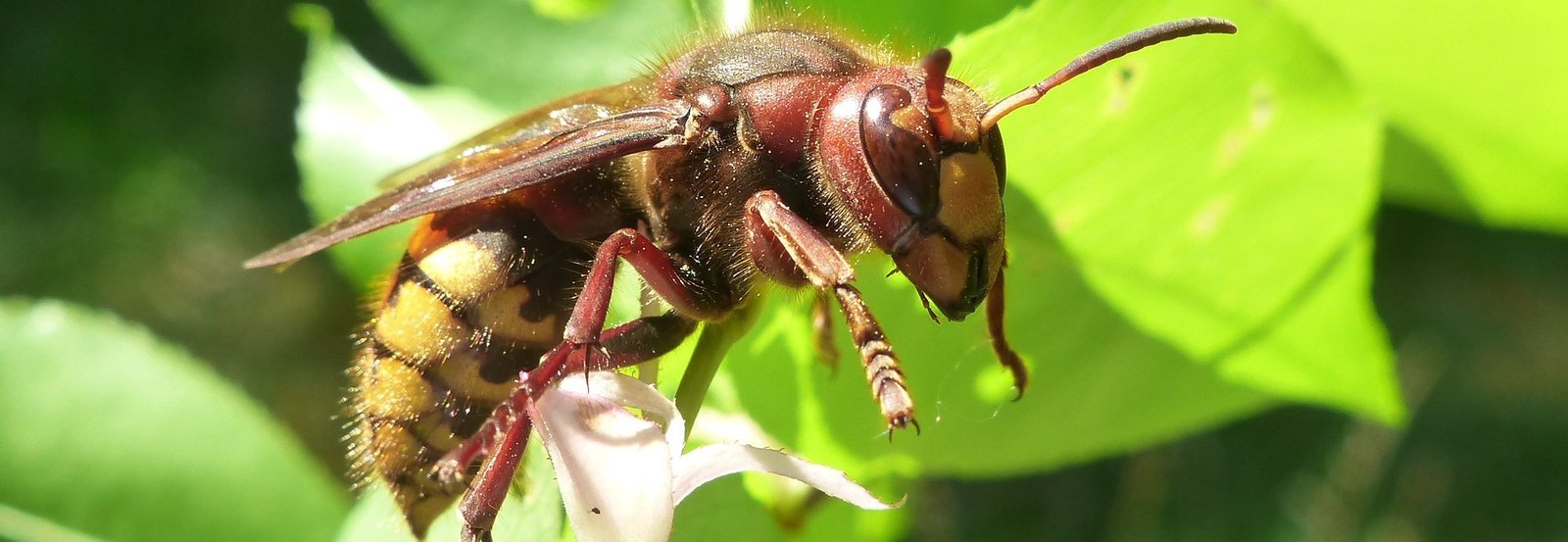European Hornet: Vespa Crabro

Description Of The European Hornet
Adult European Hornets resemble yellowjackets but are much bigger (about 11⁄2 inches) and have wide yellow markings in brown rather than yellow markings in black. The queens, which can be seen in the spring, are redder than the brown ones, and they are bigger than the workers. European hornet queens are more than 2 inches long, while workers are about 1 1/2 inches long.
They have a dark thorax (the section of the body where the wings and legs attach), and there are dark brown and black bands on the abdomen. European hornets’ head is reddish-brown, near the face becoming yellowish. 1Go To Source content.ces.ncsu.edu -“European Hornets Biting and Stinging Pests”
Learn More: Harmful Insect Species
European Hornet Behavior

The hornet colony produces males and females that mate each fall, and the females become the queens of the next year. In protected sites, under loose bark, in tree cavities, and wall voids of buildings, only the overwintering queens survive. All other members of the colony produced during the current year will perish.
The emerging queens established new nests in aerial cavities in the spring, deposit eggs in the cells they built, and fed the larvae’s first batch. In their cells, the larvae mature, pupate, and then emerge as sterile female workers. These workers are responsible for feeding the young larvae with food, collecting cellulose to expand the nest, and protecting the nest from external threats. Worker hornet hunt Crickets, grasshoppers, large flies, and caterpillars to feed to the young.
By September or October, European hornet colonies often contain 300 or more workers (maximum of 800-1,000 workers). Among the yellowjackets, these workers are unique for their ability (actually a propensity) to forage at night. It is not unusual for worker hornets during summer nights to bounce off external lights or house windowpanes. Although the worker hornets will sting if handled, they are generally not aggressive unless the colony is threatened.
In addition to the danger created by their stings, by girding the branches and twigs to collect bark for nest construction and to obtain nourishment from the sap, the hornets will also damage various trees and shrubs. 2Go To Source extension.psu.edu -“European Hornet”
Habitat Of European Hornets
Although the European hornet prefers forested areas to urban settings, near these wooded habitats are located many suburban homes in the U.S., which increases the probability of human contact.
Typically, European Hornet nests are built in hollow trees but can be found in buildings in barns, sheds, attics, and wall voids. Often, in the openings of protected cavities, nests are built. Nests built-in wall voids may emit a stench. There are usually 300-500 workers in mature nests, but they can occasionally number up to 1,000.
European Hornet Range & Distribution
The European hornet is the only actual hornet found in North America and was introduced in the 1850s introduced the New York area. The European hornet has expanded throughout most of the eastern United States since its introduction.
These hornets are now found from the eastern seaboard west to the eastern Dakotas and south to New Orleans through Iowa and Illinois. 3Go To Source hgic.clemson.edu -“EUROPEAN HORNET”
Diet Of The European Hornet
- Yellow Jackets
- Grasshoppers
- Flies
- Bees
European Hornet Relationship With Humans
Generally, European hornets avoid conflicts with humans but will defend their nests and food sources aggressively. Humans who are allergic to hornet venom, their sting may be life-threatening.
Always avoid killing a hornet anywhere near its nest, as there is a good chance of triggering an attack with the distress pheromones it releases. You should also immediately remove anything, like your clothes, that touches the pheromones from the area. The scent of certain perfumes and other volatile chemicals, which may falsely initiate an attack, can be misinterpreted by hornets.
Sources:
- Waldvogel, Michael, et al. “European Hornets.” NC State Extension Publications, N.C. Cooperative Extension, 1 Jan. 2011, content.ces.ncsu.edu/european-hornets.
- Jacobs, Steve. “European Hornet.” Penn State Extension, Penn State Extension, 8 May 2017, extension.psu.edu/european-hornet.
- —. “European Hornet | Home & Garden Information Center.” Home & Garden Information Center | Clemson University, South Carolina, Clemson Cooperative Extension, 24 Jan. 2020, hgic.clemson.edu/factsheet/european-hornet.
